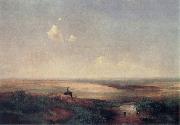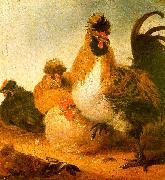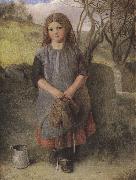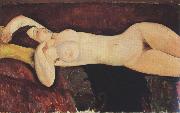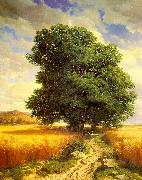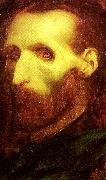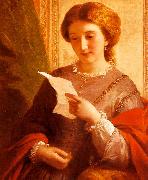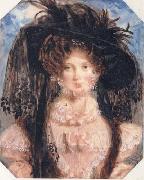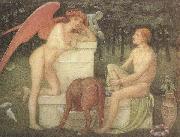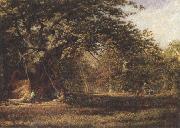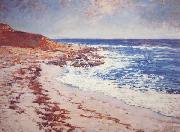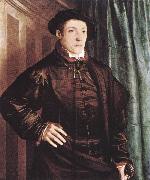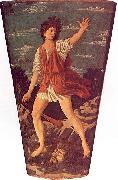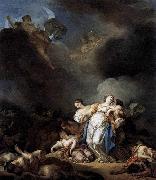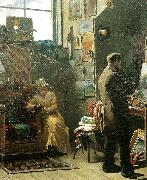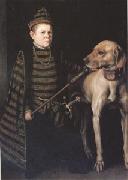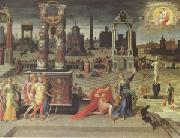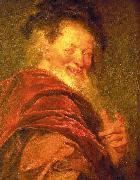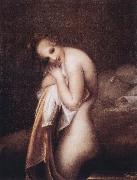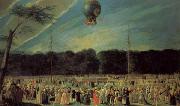|
|
|
|
|
|
 |
abstract composition
|
|
Russian painter, sculptor, designer and photographer. He was a central exponent of Russian Constructivism, owing much to the pre-Revolutionary work of Malevich and Tatlin, and he was closely involved in the cultural debates and experiments that followed the Revolution of 1917. In 1921 he denounced, on ideological grounds, easel painting and fine art, and he became an exponent of Productivism (see CONSTRUCTIVISM,
|
|
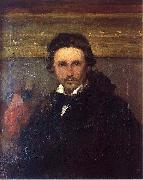 |
Adam Chmielowski
|
|
1845-1916) was a Polish religious brother and founder of the Albertines. He is a saint of the Catholic Church. Albert is also known as Brat Albert (Brother Albert); in recognition of his holiness he has also been called the "Brother of Our Lord", "Brother of Our God", and "Our God's Brother".
Adam Chmielowski was born to a wealthy aristocratic family, and initially studied agriculture with the intention of managing the family estate. Involved in politics since his youth, he lost a leg at the age of 17 while fighting in an insurrection. He became a well-known and well-liked artist in Krakew, his political convictions inspiring his interest in the human condition. A gentle and compassionate spirit, Chmielowski felt compelled to help those in need and after years of reflection, decided to follow his calling into the service of God.
In 1880, Chmielowski joined the Jesuits, took up the name Albert and abandoned painting. He began a life of service to the poor. In 1887, he founded the Brothers of the Third Order of Saint Francis, Servants of the Poor, known in honor of their founder as the Albertines or the Gray Brothers, after their rough gray habits. In 1891, he founded the women's congregation, the Gray Sisters. The Albertines organized food and shelter for the poor and homeless. |
|
|
|
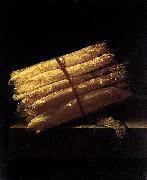 |
Adriaen Coorte
|
|
(ca. 1665 - after 1707) was a Dutch Golden Age painter of still lifes, who signed works between 1683 and 1707. He painted small and unpretentious still lifes in a style more typical of the first half of the century, and was "one of the last practitioners of this intimate category".
Very little is known of his life, but he is assumed to have been born and died in Middelburg. He became a pupil of Melchior d'Hondecoeter around 1680 in Amsterdam. From 1683 he seems to have returned to Middelburg, where he set up a workshop and signed his small, carefully balanced minimalist still lifes. He often painted on paper that was glued to a wooden panel. About 80 signed works by him have been catalogued, and nearly all of them follow the same pattern; small arrangements of fruits, vegetables, or shells on a stone slab, lit from above, with the dark background typical of still lifes earlier in the century. Instead of the Chinese or silver vessels favoured by his contemporaries, his tableware is very basic pottery. "Objects and light are studied intensely, and are painted with a wondrous tenderness".[1] Neither his birth nor death date is certain, and archival evidence only exists in Middelburg for his membership in the Guild of St. Luke there from 1695 onwards, when he was fined for selling a painting without being a member of the guild. His works appear frequently in contemporary Middelburg taxation inventories |
|
|
|
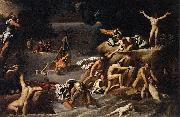 |
Agostino Carracci
|
|
(16 August 1557 - 22 March 1602) was an Italian painter and printmaker. He was the brother of the more famous Annibale and cousin of Lodovico Carracci.
He posited the ideal in nature, and was the founder of the competing school to the more gritty (for lack of a better term) view of nature as expressed by Caravaggio. He was one of the founders of the Accademia degli Incamminati along with his brother, Annibale Carracci, and cousin, Ludovico Carracci. The academy helped propel painters of the School of Bologna to prominence.
Agostino Carracci was born in Bologna, and trained at the workshop of the architect Domenico Tibaldi. Starting from 1574 he worked as a reproductive engraver, copying works of 16th century masters such as Federico Barocci, Tintoretto, Antonio Campi, Veronese and Correggio. He also produced some original prints, including two etchings.
He travelled to Venice (1582, 1587 - 1589) and Parma (1586 - 1587). Together with Annibale and Ludovico he worked in Bologna on the fresco cycles in Palazzo Fava (Histories of Jason and Medea, 1584) and Palazzo Magnani (Histories of Romulus, 1590 - 1592). In 1592 he also painted the Communion of St. Jerome, now in the Pinacoteca di Bologna and considered his masterwork. From 1586 is his altarpiece of the Madonna with Child and Saints, in the National Gallery of Parma.
In 1598 Carracci joined his brother Annibale in Rome, to collaborate on the decoration of the Gallery in Palazzo Farnese. From 1598 - 1600 is a triple Portrait, now in Naples, an example of genre painting.
In 1600 he was called to Parma by Duke Ranuccio I Farnese to began the decoration of the Palazzo del Giardino, but he died before it was finished.
Agostino's son Antonio Carracci was also a painter, and attempted to compete with his father's Academy.
|
|
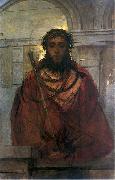 |
Albert Chmielowski
|
|
(born Adam Hilary Bernard Chmielowski; 1845 - 1916) was a Polish religious brother and founder of the Albertines. He is a saint of the Catholic Church. Albert is also known as Brat Albert (Brother Albert); in recognition of his holiness, he has also been called the "Brother of Our Lord", "Brother of Our God", and "Our God's Brother".
Adam Chmielowski was born to a wealthy aristocratic family, and initially studied agriculture with the intention of managing the family estate. Involved in politics since his youth, he lost a leg at the age of 17 while fighting in an insurrection. He became a well-known and well-liked artist in Krakew, his political convictions inspiring his interest in the human condition. A gentle and compassionate spirit, Chmielowski felt compelled to help those in need and after years of reflection, decided to follow his calling into the service of God.
In 1880, Chmielowski joined the Jesuits, took up the name Albert and abandoned painting. He began a life of service to the poor. In 1887, he founded the Brothers of the Third Order of Saint Francis, Servants of the Poor, known in honor of their founder as the Albertines or the Gray Brothers, after their rough gray habits. In 1891, he founded the women's congregation, the Gray Sisters. The Albertines organized food and shelter for the poor and homeless.
Albert believed that the great calamity of our time is that so many refuse to see and relieve the suffering of others. The so-called "haves" live away from the "have-nots", ignoring them and leaving their care to society.
|
|
|
|
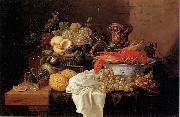 |
Alexander Coosemans
|
|
(1627, Antwerp - 1689, Antwerp), was a Flemish Baroque painter.
According to the RKD he was registered as a pupil of Jan Davidsz de Heem in 1641 and in 1645 he became a master in the Guild of St. Luke.He travelled to Rome in 1649 but was back in Antwerp in 1651. He painted flowers, fruit, and inanimate subjects, and flourished in the Netherlands about 1630. Fruit subjects by him are in the Augsburg Gallery and the Belvedere at Vienna. In the Madrid Gallery there is a fruit-piece attributed to a J. D. Cooseman, who is said to have flourished in the Netherlands in the 17th century: and in the Bordeaux Museum, a fruit-piece ascribed to a N. Coosman. He was followed by Hendrik Schoock. |
|
|
|
|
|
|
|
|
|
|
|
|
|
Alexandre-Francois Caminade
|
|
Alexandre-Francois Caminade (December 14, 1783 - May 1862) was a French painter.
Caminade was born and died in Paris. He was a portraitist and a religious painter. He was Jacques Louis David's pupil. See also, Larousse article at Cyclopedia of Painters and Paintings, eds. John Desnison Champlin and Charles Callahan Perkins |
|
|
|
|
|
|
|
|
|
|
|
|
|
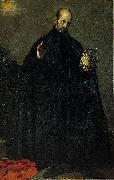 |
Alonso Cano
|
|
(19 March 1601 - 3 September 1667) was a Spanish painter, architect and sculptor born in Granada. He learned architecture from his father, Miguel Cano; painting in the academy of Juan del Castillo, and from Francisco Pacheco the teacher of Velezquez; and sculpture from Juan Martenez Montañ's. As a sculptor, his most famous works are the Madonna and Child in the church of Lebrija (also called Nebrija), and the colossal figures of San Pedro and San Pablo.
He was made first royal architect, painter to Philip IV, and instructor to the prince, Balthasar Charles, Prince of Asturias.The King gave him the church preferment of a canon of the Granada Cathedral (1652), in order to take up a position as chief architect of the cathedral, where his main achievement in architecture was the façade, designed at the end of his life and erected to his design after his death.
Ideal portrait of a Spanish King.He was notorious for his ungovernable temper; and it is said that once he risked his life by committing the then capital offence of dashing to pieces the statue of a saint, when in a rage with the purchaser who begrudged the price he demanded. According to another story, he found his house robbed after coming home one evening, his wife murdered, and his Italian servant fled. Notwithstanding the presumption against the fugitive, the magistrates condemned Cano, because he was of a jealous temper. Upon this he fled to Valencia, but afterwards returned to Madrid, where he was put to the torture, which he endured without incriminating himself, and the king received him into favour.
After the death of his wife he took Holy Orders as a protection from farther prosecution, but still continued his professional pursuits. He died in 1676. In his last moments, when the priest held to him a crucifix, he told him to take it away; according to the Catholic Encyclopedia, this was because the priest gave the Sacrament to conversos.
|
|
 |
Alonso Sanchez Coello
|
|
Alonso Sachez Coello (1531/32 -August 8, 1588) was a portrait painter of the Spanish Renaissance and one of the pioneers of the great tradition of Spanish portrait painting.
Alonso Sachez Coello was born in Benifairode les Valls, near Valencia, and spent his childhood there, until the death of his father when he was around ten years old. He was educated in Portugal at his grandfather's home. Coello's years in Portugal and his family name of Portuguese origin led to a long-standing belief that he was in fact Portuguese. His grandfather (after whom he was named) was in the service of King John III of Portugal who sent the young painter to study with Anthonis Mor (also known as Antonio Moro) in Flanders around 1550. He was under the service of Antoine de Granville, bishop of Arras, learning from Mor. While studying in Flanders, Coello also spent time copying some of Titian's works. |
|
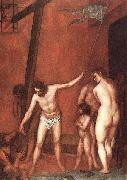 |
Alonzo Cano
|
|
Alonzo Cano or Alonso Cano (19 March 1601 - 3 September 1667) was a Spanish painter, architect and sculptor born in Granada. He learned architecture from his father, Miguel Cano;painting in the academy of Juan del Castillo, and from Francisco Pacheco the teacher of Velezquez; and sculpture from Juan Martenez Montañes. As a sculptor, his most famous works are the Madonna and Child in the church of Lebrija (also called Nebrija), and the colossal figures of San Pedro and San Pablo.
He was made first royal architect, painter to Philip IV, and instructor to the prince, Balthasar Charles, Prince of Asturias. The King gave him the church preferment of a canonof the Granada Cathedral (1652), in order to take up a position as chief architect of the cathedral, where his main achievement in architecture was the façade, designed at the end of his life and erected to his design after his death.[citation needed]
Ideal portrait of a Spanish King.He was notorious for his ungovernable temper; and it is said that once he risked his life by committing the then capital offence of dashing to pieces the statue of a saint, when in a rage with the purchaser who begrudged the price he demanded.[1] According to another story, he found his house robbed after coming home one evening, his wife murdered, and his Italian servant fled. Notwithstanding the presumption against the fugitive, the magistrates condemned Cano, because he was of a jealous temper. Upon this he fled to Valencia, but afterwards returned to Madrid, where he was put to the torture, which he endured without incriminating himself, and the king received him into favour.
After the death of his wife he took Holy Orders as a protection from farther prosecution, but still continued his professional pursuits. He died in 1676. In his last moments, when the priest held to him a crucifix, he told him to take it away; according to the Catholic Encyclopedia, this was because the priest gave the Sacrament to conversos. |
|
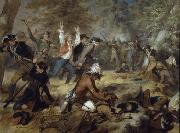 |
Alonzo Chappel
|
|
Alonzo Chappel (1828 - 1887) was an American painter, best known for paintings depicting personalities and events from the American Revolution and early 19th-century American history.
Chappel was born in New York City and died in Middle Island, New York. |
|
|
|
|
|
 |
Amaldus Clarin Nielsen
|
|
(23 May 1838 - 10 December 1932) was a Norwegian painter.
He was born in Halse as a son of shipmaster and merchant Niels Clemetsen Nielsen (1795 - 1845) and his wife Andrea Marie Møller (1802 - 1866). He grew up in Mandal in Vest-Agder county, Norway. He lived most of his childhood and adolescence without a father. He received some tuition from a traveling drawing teacher and traveled to Copenhagen to study in 1854
|
|
|
|
 |
Andien de Clermont
|
|
Andien de Clermont (d.1783) was a French artist who worked in England in the 18th century (ca.1716-1756). He was particularly known for his decorative flower paintings in the Rococo style, and for "singeries, chinoiseries, and turqueries." He decorated interiors at Kirtlington Park, Langley Hall, Wentworth Castle, Wilton House, and "the second earl of Strafford's (now destroyed) dining room at No. 5 St. James's Square, London."
|
|
|
|
|
|
|
|
|
|
|
|
|
|
|
|
|
|
|
|
 |
Antoine Chintreuil
|
|
Antoine Chintreuil
Antoine Chintreuil (May 15, 1814 - August 8, 1873) was a French landscape painter.
He was born in Pont-de-Vaux, Ain and grew up in Bresse. In 1838 he moved to Paris, where he began studying under Paul Delaroche in 1842. The following year he met Corot, who influenced him profoundly by encouraging him to paint landscape en plein air.
Art historian Athena S. E. Leoussi suggests that Chintreuil's work can be divided into three periods: From c. 1846-1850 he painted Paris and its surroundings, particularly Montmartre; from 1850-1857 he lived in Igny and frequently painted in Barbizon, and from 1857 on he lived and worked in La Tournelle-Septeuil in the Seine valley. During this final period his work reached its fullest development, and he achieved critical recognition.
In the breadth and simplicity of his execution, and in his attention to capturing light and atmosphere, Chintreuil can be placed alongside Eugene Boudin, Johan Barthold Jongkind, and the painters of the Barbizon school, as an important forerunner of Impressionism.
He died in Septeuil, Seine-et-Oise in 1873. |
|
|
|
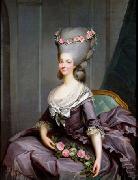 |
Antoine-Francois Callet
|
|
(1741-1823, Paris), generally known as Antoine Callet, was a French painter of portraits and allegorical works, who acted as official portraitist to Louis XVI.
He won the grand prix de Rome in 1764 with Cleobis et Biton conduisent le char de leur mere au temple de Junon (Kleobis and Biton dragging their mother's cart to the temple of Juno). He was accepted by the Academie des beaux arts in 1779, with his entry piece being a portrait of the comte d'Artois, and received with his allegory Le printemps (Spring) in 1781. He exhibited at the Salon from 1783 onwards. He painted the centre of the ceiling of the grande galerie of the palais du Luxembourg, with a composition entitled L'Aurore (Aurora). Under the French Consulate and the First French Empire he painted several more allegories, including an Allegorie du dix-huit brumaire ou la France sauvee (Allegory of 18 Brumaire, or France saved - 1801, château de Versailles) and an Allegorie de la bataille d'Austerlitz (Allegory of the Battle of Austerlitz - 1806, château de Versailles).
|
|
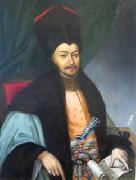 |
Anton Chladek
|
|
painted Portrait of Ienachita Vacarescu in 1794 - 1882 |
|
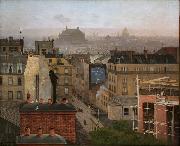 |
Antonin Chittussi
|
|
(1 December 1847 - 1 May 1891) was a Czech Impressionist landscape painter.
He was born in Ronov nad Doubravou to a Czech mother and a father of Italian descent. He was fascinated by the landscape of South Bohemia and of the Bohemian and Moravian Highlands. In particular, his smaller pictures replete with quick, easy brushstrokes are among the most admired of Czech landscape painting. He died in Prague.
|
|
|
|
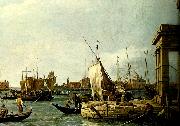 |
antonio canaletto
|
|
Giovanni Antonio Canal (28 October 1697 - 19 April 1768) better known as Canaletto, was a Venetian painter famous for his landscapes, or vedute, of Venice. He was also an important printmaker in etching. |
|
|
|
|
|
|







